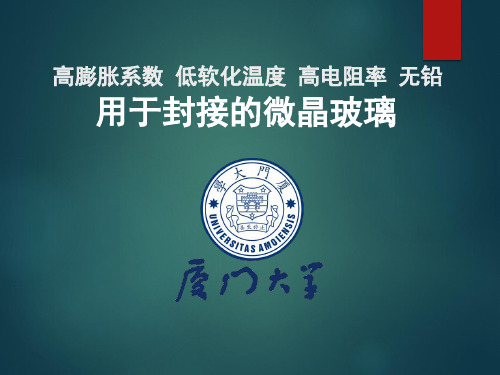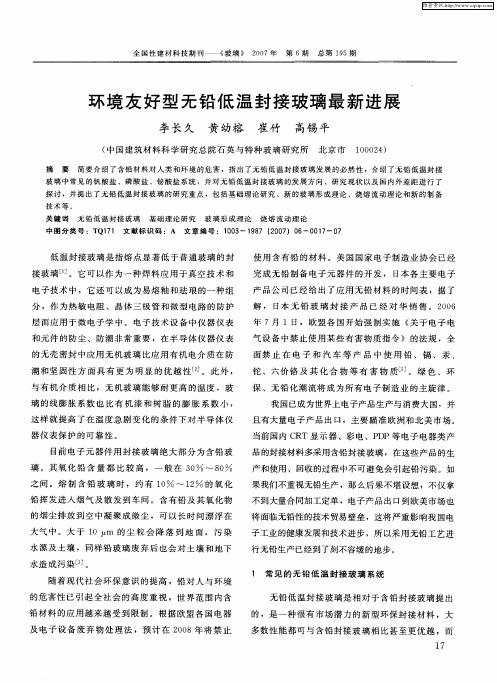低熔封接微晶玻璃无铅化的最新研究进展及其发展趋势
- 格式:pdf
- 大小:232.43 KB
- 文档页数:4

Bi2O3-ZnO-B2O3低熔点玻璃的研究摘要纳米级微晶玻璃的低析晶温度导致其在实际应用中难以密致封接的困难。
故本研究为解决此为题提出了方案,研究出一个具有低熔点和一定稳定性的玻璃体系,作为一种辅助剂加入到原有的玻璃粉体中,能够改善封接玻璃的致密性,实现封接玻璃的高化学稳定性和良好的封接性能。
本实验经过二元、三元乡图的搜索,确定了Bi2O3-ZnO-B2O3体系的玻璃配方,通过熔融法成功制备熔点为590-670o C的玻璃样品,其软化点为370-420o C(较目前商业化产品降低20%)范围内的低熔点封接玻璃。
其在150-300o C范围内热膨胀系数为1.2-1.4 X10-5/K,显著改善其封接性能;同时,该材料置于80o C热水中1000小时具有良好的稳定性。
关键字:Bi2O3-ZnO B2O3系统,低熔点封接玻璃,微晶玻璃1简介低熔点玻璃对于封接材料来说至关重要,因为它的性能如玻璃化转变温度、热膨胀系数以及软化点等等都能够根据其配方的调整而方便地调控。
铅作为一种有毒物质广泛地运用于低熔点玻璃的领域,因为它的添加能够显著地降低玻璃的热特征温度。
然而,考虑到环境的保护,我们必须开发出一种无铅的低熔点玻璃,以替代在低温玻璃界普遍使用的含铅体系。
对于封接玻璃来说,最使用的是它的软化点和热膨胀系数(CTE),前者对于封接的密封性非常重要,而后者对于封接元件的机械强度起影响很大。
必须保证被封接器件不会再热循环的过程中因为应力的产生而开裂导致封接失效。
2在相图中寻找低熔点的体系2.1二元体系相图我们先在二元相图中寻找低共晶点的体系如图1所示,我们找到了具有630 o C 左右熔点的B-Bi 二元系统。
图1 Bi2O3-B2O3系统E. M. Levin and C. L. McDaniel, J. Am. Ceram. Soc., 45 [8] 355-360 (1962).2.2三元体系相图基于二元B-Bi系统拥有低共晶点的搜索结果,我们进一步在三元乡图中进行寻找更低熔点的三元共晶体系。

2024年微晶玻璃面板市场分析现状引言微晶玻璃面板是一种具有高光学透明度、高强度和高硬度的特殊玻璃制品。
它在电子产品、建筑装饰、医疗器械等领域具有广泛的应用。
本文将对微晶玻璃面板市场进行分析,包括市场规模、产业发展现状、竞争格局等方面的内容。
市场规模微晶玻璃面板市场的规模不断扩大。
随着人们对高品质显示和装饰需求的增加,微晶玻璃面板作为一种高性能材料,受到广泛关注和应用。
根据市场调研数据显示,2019年全球微晶玻璃面板市场规模达到XX亿美元,预计到2025年将增长至XX亿美元。
产业发展现状技术发展微晶玻璃面板的生产制造技术在不断提升。
当前,主要的微晶玻璃面板制造技术包括热熔法、热压法、离子交换法等。
随着先进技术的引入和改进,微晶玻璃面板的生产效率和质量得到了显著提升。
应用领域微晶玻璃面板在电子产品领域有广泛的应用。
例如,智能手机、平板电脑、电视等消费电子产品都使用了微晶玻璃面板作为显示屏的保护材料。
此外,微晶玻璃面板还在建筑装饰、医疗器械等领域展示出了广阔的应用前景。
市场竞争格局微晶玻璃面板市场竞争激烈。
当前,全球范围内存在着众多微晶玻璃面板制造商。
主要的竞争对手包括公司A、公司B、和公司C等。
这些公司在技术研发、产品质量和市场推广方面都拥有一定的竞争优势,为市场带来了更多的选择。
市场趋势与应对策略市场趋势微晶玻璃面板市场在未来有望继续保持增长态势。
一方面,随着科技进步和消费升级,人们对高品质和高性能显示设备的需求不断增加;另一方面,新兴领域的市场需求也将成为市场增长的新动力。
应对策略为了应对市场发展趋势,微晶玻璃面板制造商需要不断提升产品质量和技术水平,不断创新以满足消费者的需求。
此外,积极开拓新兴市场、加强产品差异化竞争也是重要的应对策略。
结论微晶玻璃面板市场作为一种高性能材料的应用领域不断扩大。
市场规模不断增长,产业发展现状不断优化,但竞争格局也相应加剧。
微晶玻璃面板制造商需要抓住市场趋势,不断提升技术,推出高品质产品,积极应对市场竞争,以实现可持续发展。




2024年微晶玻璃市场发展现状引言微晶玻璃是一种独特的玻璃材料,具有细致的晶体结构和较高的硬度,因此在众多应用领域中得到了广泛的应用。
本文将对2024年微晶玻璃市场发展现状进行探讨,分析其应用领域和市场前景。
微晶玻璃的性质和特点微晶玻璃是一种非晶态玻璃,其晶体尺寸通常在纳米到微米级别,具有以下特点:1.高硬度:微晶玻璃硬度较高,通常在6-7级(摩氏硬度),相比普通玻璃更加耐磨损。
2.优异的光透性:微晶玻璃具有较高的透光率,可以有效地传递光信号,在光学设备领域有广泛应用。
3.优良的化学稳定性:微晶玻璃具有较低的化学活性,可以抵御大多数化学物质的侵蚀,具有良好的耐腐蚀性。
4.良好的热稳定性:微晶玻璃具有良好的热稳定性,在高温环境下也能保持较好的稳定性。
微晶玻璃的应用领域1.光学器件:由于微晶玻璃具有优异的光学特性,可以用于制造光学透镜、光学窗口等光学器件。
2.电子产业:微晶玻璃可以制成高硬度的显示屏保护层、触摸屏面板等电子产品的关键零部件。
3.医疗领域:微晶玻璃具有良好的生物相容性和耐腐蚀性,可以用于制造人工关节、医疗器械等医疗器械。
4.化工领域:微晶玻璃的化学稳定性使其成为化工设备的理想材料,被广泛应用于化工反应容器、传热设备等。
5.其他领域:微晶玻璃还可以应用于建筑、汽车、航空航天等领域,用于制造建筑玻璃、汽车玻璃、航空航天器件等。
2024年微晶玻璃市场发展现状当前,微晶玻璃市场正在快速发展,主要有以下几个方面的现状:1.市场规模扩大:随着微晶玻璃应用领域的不断拓展,市场需求不断增加,市场规模正在逐年扩大。
2.技术创新:微晶玻璃制备技术和加工技术在不断创新,使得微晶玻璃的制造成本不断降低,产能不断提升。
3.行业竞争激烈:由于微晶玻璃市场前景广阔,吸引了众多企业的关注,行业竞争激烈,需要不断提高产品质量和技术水平来保持竞争力。
4.地区分布不均:微晶玻璃市场的地区分布不均,目前国内一些发达地区的微晶玻璃产业比较集中,但其他地区的发展也逐渐加快。
微晶玻璃行业市场现状分析及未来三到五年发展趋势报告Title: Analysis of the Current Status of the Microcrystalline Glass Industry Market and Report on the Future Development Trends in the Next Three to Five YearsMicrocrystalline glass, also known as crystallized glass panel, is a type of high-grade building decoration material. It has gained significant traction in recent years due to its unique properties and versatile applications. As the market for microcrystalline glass continues to grow, it is essential to conduct an in-depth analysis of its current status and predict the future development trends. This report aims to provide a comprehensive understanding of the microcrystalline glass industry market and its anticipated development over the next three to five years.Market Current Status:The microcrystalline glass industry has witnessed steady growth in recent years, driven by factors such as increasing demand for high-quality building materials, advancements intechnology, and the growing focus on sustainable construction practices. The market for microcrystalline glass is primarily segmented into applications such as flooring, wall cladding, countertops, and other interior and exterior decorative surfaces. Additionally, the use of microcrystalline glass in furniture and art installations has also contributed to its market expansion.In terms of regional market dynamics, Asia-Pacific, particularly China, has emerged as a major consumer and producer of microcrystalline glass. The region's rapid urbanization and infrastructure development have propelled the demand for innovative and aesthetically appealing construction materials, thereby driving the growth of the microcrystalline glass market. Furthermore, Europe and North America have also witnessed notable adoption of microcrystalline glass in architectural projects, indicating a global trend towards its widespread use.Future Development Trends:Over the next three to five years, several key trends are expected to shape the development of the microcrystalline glassindustry. First and foremost, technological advancements in manufacturing processes are anticipated to enhance the quality and diversity of microcrystalline glass products. This includes the development of larger panel sizes, thinner thicknesses, and improved surface finishes, allowing for greater design flexibility and architectural possibilities.Moreover, the industry is likely to witness increased focus on sustainability and environmental consciousness. Manufacturers and consumers are expected to prioritizeeco-friendly production methods and recyclability, aligning with global efforts towards sustainable development. As a result, the demand for microcrystalline glass as a green building material is projected to rise, particularly ineco-conscious markets.Furthermore, the expansion of applications beyond traditional architectural uses is poised to drive market growth. The versatility of microcrystalline glass opens up opportunities for its utilization in various industries, such as automotive, aerospace, and electronics. Additionally, the integration of smart technologies and innovativefunctionalities, such as self-cleaning and energy-efficient properties, will further enhance the appeal of microcrystalline glass in the market.In conclusion, the microcrystalline glass industry is set to undergo significant developments in the coming years, driven by technological advancements, sustainability initiatives, and diversification of applications. Stakeholders in the industry should remain vigilant of these trends and capitalize on emerging opportunities to maintain a competitive edge in the market.中文:微晶玻璃,也被称为晶化玻璃板,是一种高级建筑装饰材料。